STATES AND UNION TERRITORIES OF INDIA
KARNATAKA
Bylakuppe
Text & Photos: Lalitha Venkat
Bylakuppe
is about 85km from Mysore, on the way to Madikeri in Coorg. A 2 hour drive.
A couple of
km before Kushal Nagar is a yellow sign Namdroling Monastery on
the right. You turn to the left of the road and come to a row of small
shrines and a stupa. There’s a sign on the stupa that reads, "This stupa
was built by the Tibetan Youth Congress Bylakuppe in memory of those patriots
who have sacrificed their precious lives for the cause of the Tibetan freedom
since 1949. His Holiness the XIVth Dalai Lama of Tibet consecrated the
stupa in person on 15.12.1986."
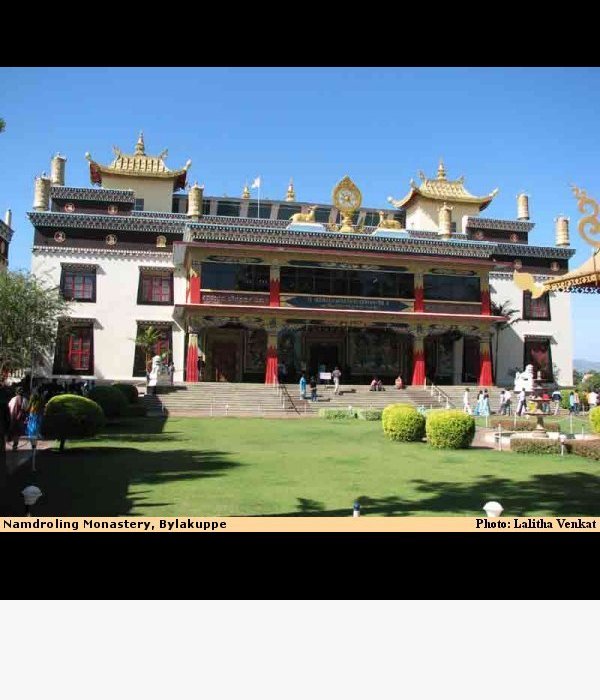
Bylakuppe, Karnataka

Bylakuppe, Karnataka
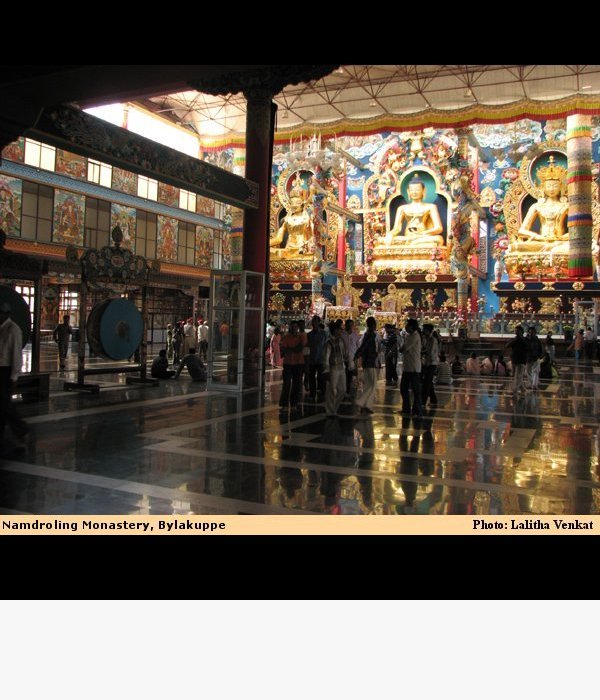
Bylakuppe, Karnataka
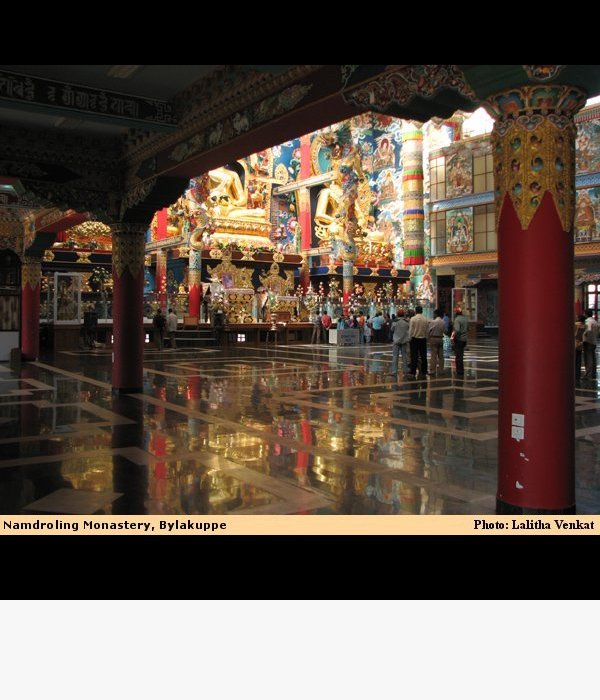
Bylakuppe, Karnataka
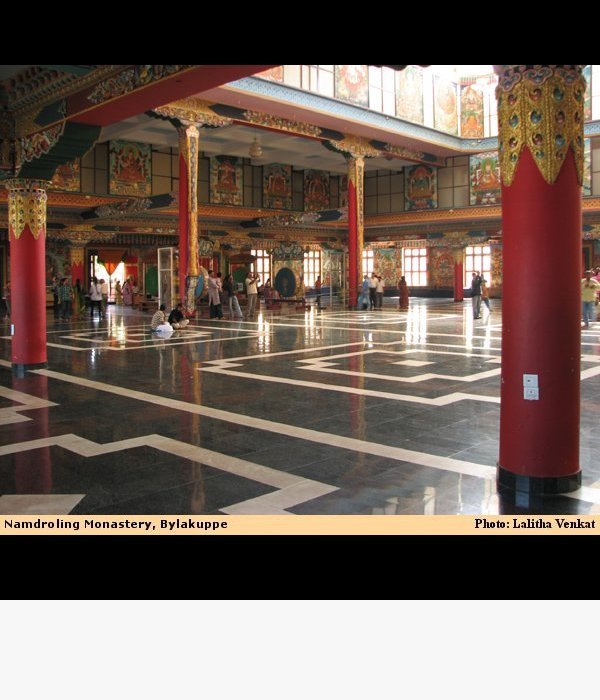
Bylakuppe, Karnataka
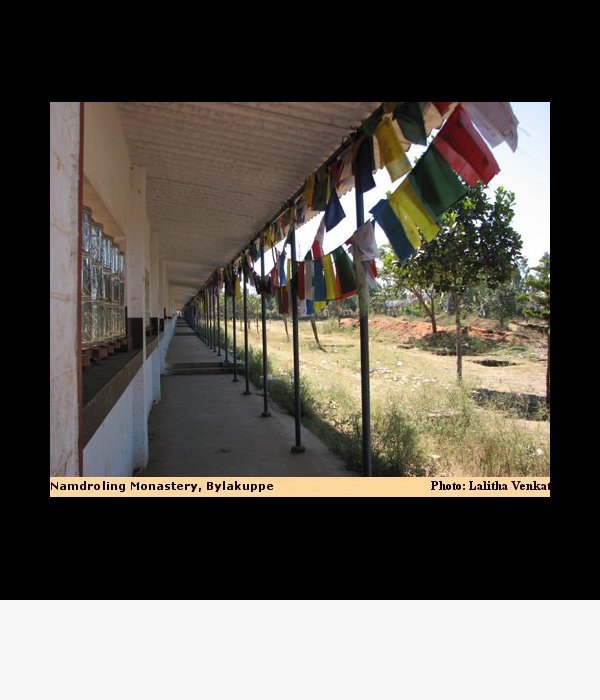
Bylakuppe, Karnataka
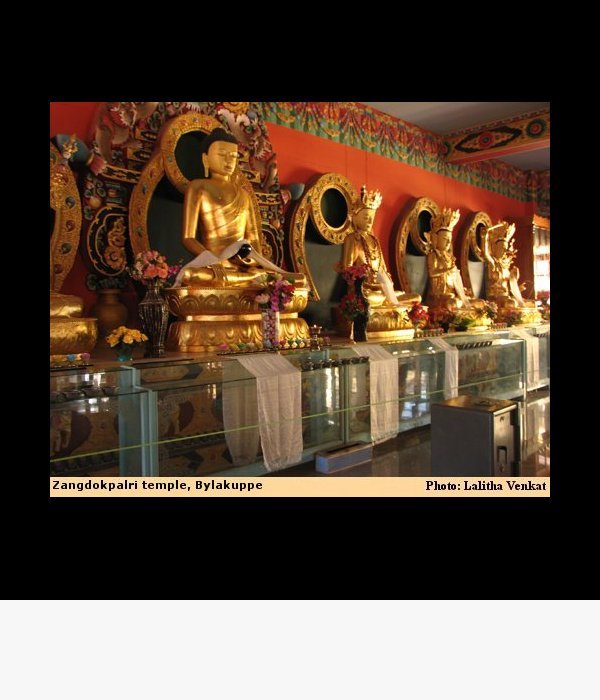
Bylakuppe, Karnataka
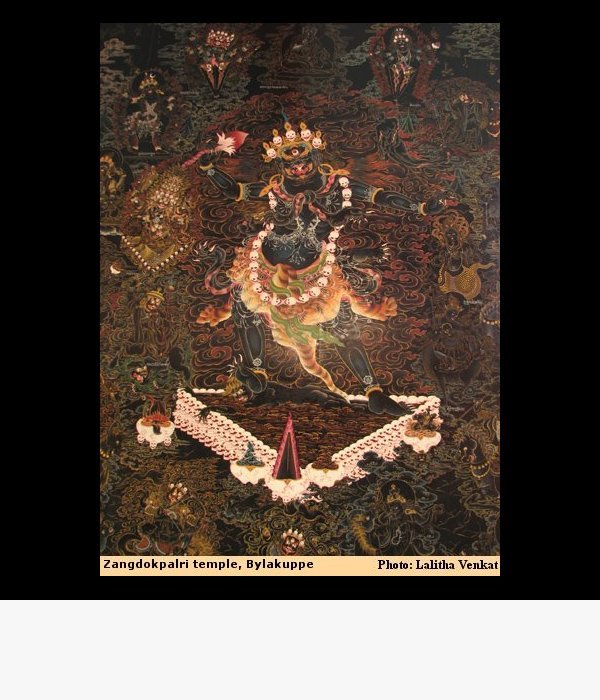
Bylakuppe, Karnataka
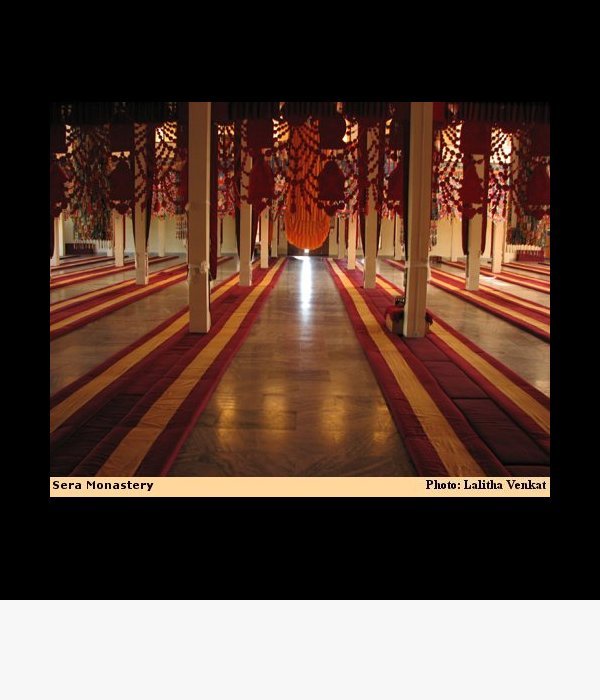
Bylakuppe, Karnataka
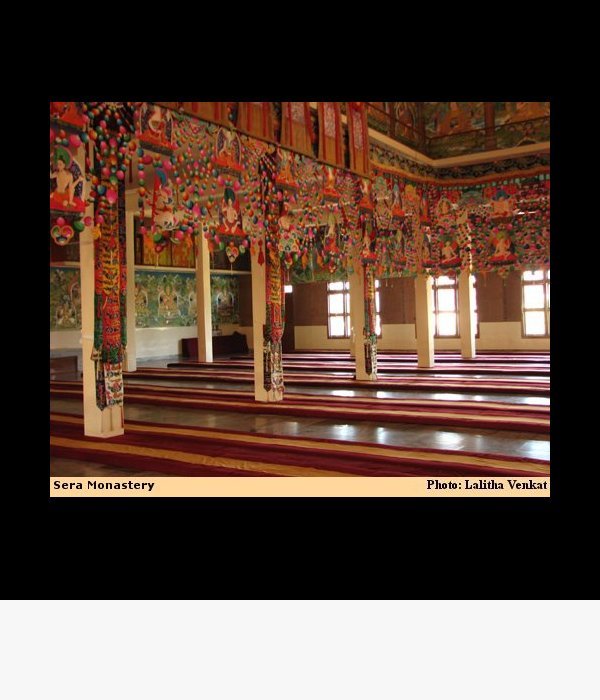
Bylakuppe, Karnataka
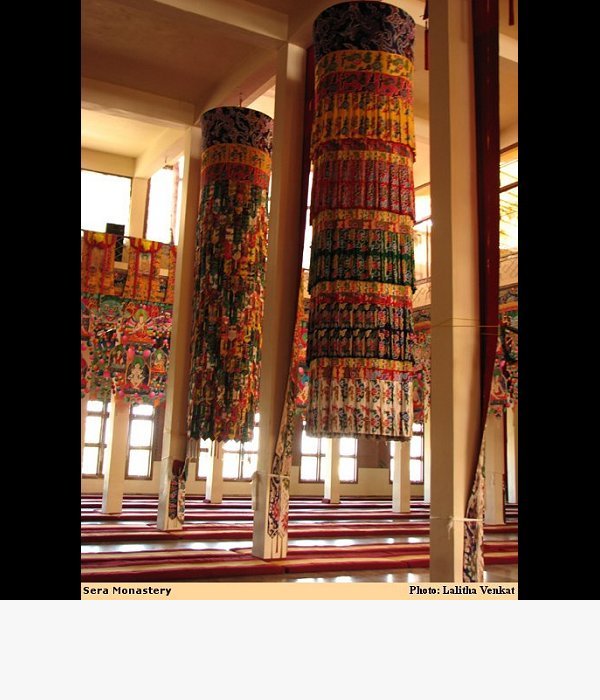
Bylakuppe, Karnataka
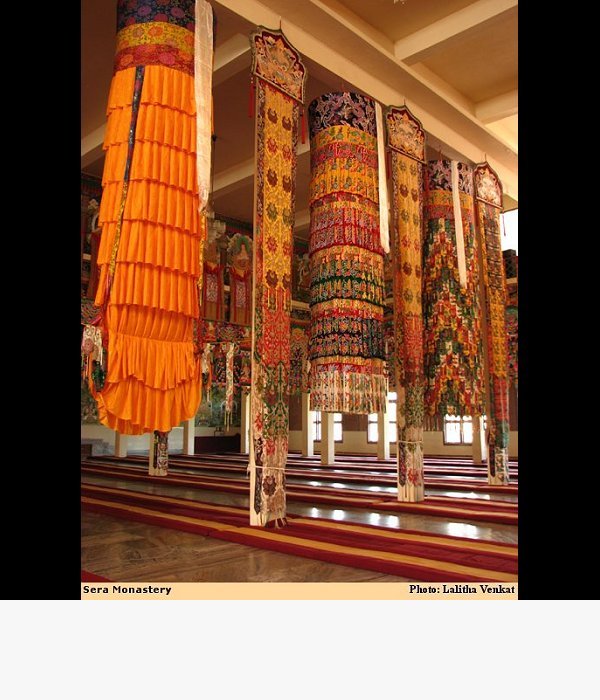
Bylakuppe, Karnataka
Across the
road is what looks like storehouses, with signs on the walls. One says,
"Boycott Chinese goods. Love India, Buy Indian." One already gets
a feeling of being in Tibet! After the temples is a sign Lugsung Samdupling
First Camp and beyond that is a little shopping complex selling Tibetan
and other goods. It's 5 km from there to Namdroling Monastery. It is now
a thriving community and home to thousands of lamas, monks and nuns, making
it the largest Nyingmapa teaching center in the world. The sign outside
says Nyingmapa Monastery on the ornate entry gateway. It is Rs.5 for car
parking fee.
From the gate,
you walk across a vast courtyard flanked by quarters. On the right is a
low gate. As you enter, up ahead you see a wide walkway leading to the
highly ornate Zangdokpalri ("Copper-colored Mountain") temple. The
path has designs like conch, flower vase etc painted on it. The tower is
highly ornate and crowned with a rainbow on which protective spirits -
Dakas and Dakinis - dance against the sky.
The outer
walls flanking the doorway are decorated with huge, colorful murals. The
doors, red in color, have huge gold knockers and a thick plaited rope with
tassels hanging from it. This is so for all the doorways of all the religious
structures at Bylakuppe. This temple was completed in 2004 to commemorate
the anniversary of Guru Rinpoche and consecrated by the Dalai Lama on Dec
13, 2004.
Because the
new temple has less room, the main ceremony was then moved to the Golden
Temple where over 12,000 monks gathered including those from Namdroling,
the Sera Monastery, and three major Gelugpa Monasteries, Kagyu Monastery
and others. The kitchen estimated 16,000 meals were served at lunch including
1,000 outside visitors, 1,000 Indian guests and 2,000 local lay Tibetans.
To the left
of Zangdokpalri temple is a small garden with fountain, leading to a flight
of steps up to the massive Padmasambhava Buddhist Vihara, built in typical
Tibetan style. The Dalai Lama inaugurated it in September 1999. The atmosphere
is very tranquil. You have to leave your footwear outside at the shoe stall.
Huge murals on the outer walls are grand and the interior is even grander.
As soon as you enter this Golden Temple, as it is popularly known, you
will be astounded by the sight of the expanse before you, the shiny floor,
the 40' high gilded images of Guru Padmasambhava, Buddha Sakyamuni and
Amitayus - the Buddha of long life - at the far end. Half way down the
hall are 2 gongs with a sign that says 'Don't touch!' The pillars are red
in color. The walls are totally covered in exotic paintings in bright hues.
On the left wall are 5 big and 2 small panels at the end; on the right
are 8 big and 2 small panels at the end. There are 3 massive doors to the
hall. Only the central one is open and it is flanked by 4 big panels and
2 small panels at the ends.
The altar is
highly ornate with spiral columns separating the 3 idols and peopled by
dragons and divine figures. Dozens of chirping sparrows fly in and out
and one wonders how the management is able to keep the place clean of sparrow
droppings! There are rows of religious objects below the idols. To the
right of the altar is a mural covering the whole wall space. There is a
small board with this information. 1st floor refers to the ground level.
"Wall paintings
on both sides of the 3 statues depict the 25 disciples of Guru Padmasambhava
who attained high realizations through the practice of Dzogchen teachings.
Depicted
on the wall behind the 3 statues are the Goddesses of offering. The paintings
on both sides of the 3rd floor show the life story of Buddha and 12 great
teachers of Dzogchen.
Those on
both sides of 2nd floor represent the 11 throne holders of the Palyul tradition
and the great scholars and masters of the Nyingma tradition. The murals
on the 1st floor mainly show the various deities of the Three Roots (Lama,
Yidam and Dakini). One can clearly see the influence of Tantric Buddhism
in these paintings.
Deities
in wrathful form, also male and female deities in union are seen. According
to Tantric Buddhism, peaceful deities wear silk garments and ornaments
made of precious metals and stones; wrathful deities wear skins of living
beings and bone ornaments. To shed some light on the topic, the Buddhas
appear to be wrathfully holding weapons in their hands and also some male
deities entwined with their female counterparts, not by their own will,
but they show these appearances in order to tame the beings of different
mentalities. Buddha appears wrathful to ferocious beings who inflict harm
on others, to tame them. The Buddhas in union with their consorts represent
the need for the union of the wisdom and compassion aspects of the path.
Without the union of these 2, it is impossible to attain enlightenment."
The rear of the
building is also ornate with a couple of small pools on either side of
the central staircase. The garden around is green and beautiful.
As you walk
around and come to the side of the vihara, a big gate (to its right are
the rest rooms) leads into a vast open ground where to the left, one usually
finds monks of all ages, generally playing cricket! Beyond that are rows
of silver prayer wheels arranged along long, straight corridors running
the length of the ground. You turn them right to left and not otherwise!
There's a tiny
prayer hall on the side of the vihara beyond the shoe stall. One can hear
chanting from there during prayer times. The dark maroon and yellow robes
of the big and little monks stand out in the greenery of the surroundings.
Lama Rinpoche established the Namdroling monastery, the Golden Temple and
the Monastic institute at the monastery. He built the temple to accommodate
the growing population of monks and nuns in the monastery.
After visiting
the Golden Temple, you drive past the Tibetan Medical Center and then 3km
to the New Sera Mey Mahayana Monastery, passing by buildings built
in Tibetan style. Sera village is the site of the Sera Je and Sera Mey
monasteries. The building is situated in a huge enclosure with designs
painted in front of the wide flight of steps, leading up to the hall. One
can see beehives hanging from under the window eaves in most buildings!
A sign on the right wall of the verandah reads, "Sera Mey Monastic University
inaugurated and consecrated by His Holiness XIVth Dalai Lama of Tibet on
Nov 26, 2002."
One of the
monks leads us into the hall. It is a vision in red. The décor is
very different from Namdroling, the ambience is just right for meditation...There
are long parallel rows of maroon mattresses striped with yellow for monks
to sit on and pray. Rows are demarcated by pillars and huge dangling toranams
made of rich brocaded material overlapping in a cascade of leaf patterns
hang in the central part of the hall. The altar is different here. The
sunlight filtering in through the glass panes give a strange sense of timelessness.
For more information visit
palyul.org/eng_centers_namdrol.htm
|